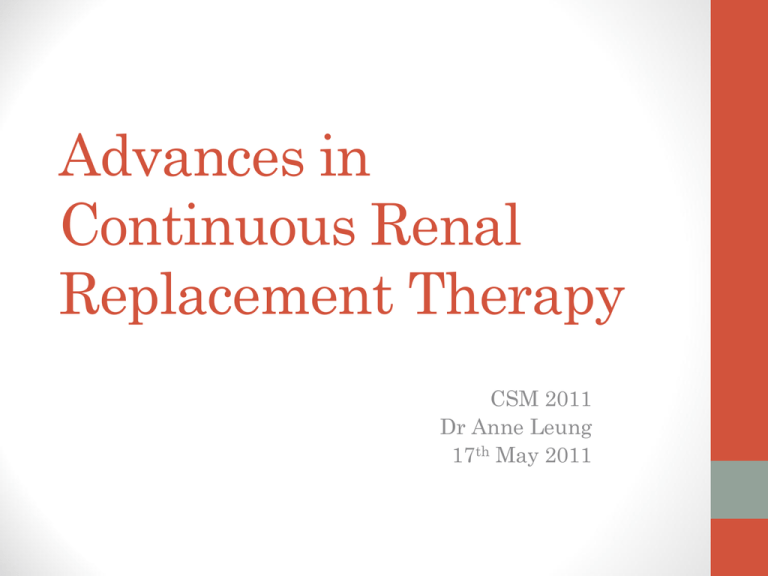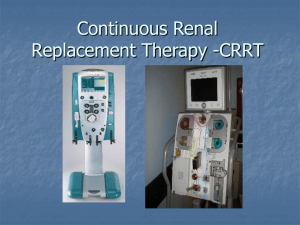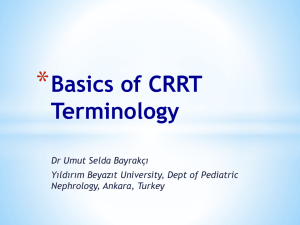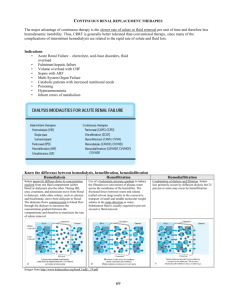Dr Anne Leung
advertisement

Advances in Continuous Renal Replacement Therapy CSM 2011 Dr Anne Leung 17th May 2011 Overview Timing of initiation Membrane Fluid and anticoagulation To begin the “Dosing” story of CRRT…. 20mL/Kg/hr 35mL/Kg/hr 45mL/Kg/hr 15-days Survival 41% 57% 58% Lancet 2000 Higher the dose the better Piccinni ICM 2006 EIHF vs Conventional 45mL/Kg/hr for 6 hours then 20mL/Kg/hr vs 20mL/Kg/hr 28-day Survival: 55% vs 27.5% CVVHDF: more may not be better Tolwani et al JASN 2008 PRCT Single Center N=200 Pre-dilution CVVHDF: 20mL/Kg/Hr CVVDHF: 35mL/Kg/Hr Intense Conventional Hemodynamic stable IHD /SLED 6x/week with Kt/V of 1.2-1.4 IHD /SLED 3x/week with Kt/V of 1.2-1.4 Hemodynamic unstable CVVHDF 35mL/Kg/Hr CVVHDF 20mL/Kg/Hr Intensive RRT = Equal ATN trial PRCT N=1124 60 days mortality Intensive: 53.6% Less Intensive: 51.5% What Dose ? • Before the ATN trial • CRRT: 35mL/Kg/Hr • Daily iHD • After the ATN trial • SOFA 0-2: 3x/week iHD (Kt/V 1.2) • SOFA 3-4: CRRT 20 mL/Kg/hr or SLED 3x/week • But beware for the need for extra treatment! Randomized (Post-dilution CVVH) 1508 Low dose (25ml/Kg/hr) 761 Lost to follow-up = 0 Consent withdrawn = 2 Consent not obtained = 16 Analyzed 743 High dose (40ml/Kg/hr) 747 Lost to follow up = 1 Consent withdrawn = 2 Consent not obtained = 23 Analyzed 722 RENAL Study High Intensity Low Intensity 90-days mortality 44.7% 44.7% 28-days mortality 38.5% 36.5% Conclusion • Intensity of RRT DOES matter • Beyond the threshold dose ( 25ml/kg/hr), increasing intensity does not provide further clinical benefit • Be-aware of the difference between prescribed and delivered dose of RRT • ATN study: 89% -95% • RENAL study: 84-88% • Minimize the interruption of the treatment time IVOIRE (hIgh Volume in Intensive Care)—French Study • Inclusion criteria: Septic shock <24 hrs and RIFLE criteria of injury or worse • Intervention: High volume (70ml/kg/hr) vs Standard (35ml/Kg/hr) for 96 hours • Patient number: total of 460 patients • Primary outcome: 28-day mortality • Study period: 3 years and completed by Oct 2010 INITIATION OF THERAPY RIFLE Criteria Level of injury Outcome measures Currr Opin Crit Care 8: 509-514 (2002) From RIFLE to AKIN Serum Creatinine Stage 1 Increase SCr ≥24.6mmol/L Stage 2 2-3 folds Stage 3 The Acute Kidney Injury Network Classification ( AKIN) Crti Care 11:R31 (2007) Biomarkers of AKI uNGAL Serum Cystatin C MEMBRANE OF FILTER Super High-Flux or High Cut-ff Membranes Achieve greater clearance of inflammatory cytokines - Superior elimination of IL-6 - Decrease need of Noradrenaline over time P. 20 SepteX—High Cut Off Membrane Pilot Randomized Controlled Study Comparing the Effect of High Cut-off Point Hemofiltration with Standard Hemofiltration in Patient with Acute Renal Failure • Study Population: • Critically ill patient with AKI and shock that require Nor-adrenaline • Intervention: • Standard polyamide high flux membrane vs High cut-off polyamide membrane (P2SH) • CVVH: Qb: 200ml/min, UF of 25ml/Kg/hr • Size of the study: • 72 patients • Primary measures • NA-free time in first week after randomization • Status: • start in Jun 2009 and still recruiting Early Use of Polymyxin B Hemoperfusion in Abdominal Septic Shock--The EUPHAS Randomized controlled Trial JAMA 2009 P. 22 Early Use of Polymyxin B Hemoperfusion in Abdominal sepsis Decrease vasopressor requirement Better BP and low SOFA score Polymyxin B immobilized fiber Direct Hemo-Perfusion Mortality of 32 % vs 53% FLUID & ANTICOAGULANT Continuous renal replacement therapy: B.E.S.T. Kidney (The Beginning and Ending Supportive Therapy for the kidney). a worldwide practice survey. 23 Countries, 54 ICUs, 1006 patients with ARF on CRRT Nafamostat LMWH 6% 4% Citrate 10% Others 4% UFH 43% No anticoagulant 33% Intensive Care Med. 2007;33(9):1563-70 Less clotting in Hollow Fibers membrane Kid Int 1999 Commercial preparation of citrate solution—Morgera S. et al .CCM 2009 Gp 1 (60Kg) Gp 2 (6090Kg) Gp 3 (>90Kg) Patient No 19 97 45 Blood flow (mL/min) 80 100 120 Dialysate flow (mL/hr) 1500 2000 2500 Citrate flow( mL/hr) 140 170 205 A safe citrate anticoagulation protocol with variable treatment efficacy and excellent control of the acidbase status—CCM 2009 • Result • Median filter time of 61.5 hrs • 5% had filter clot • Excellent control of acidbase and electrolyte Use of citrate CVVH was safer and reduced mortality Oudemans MH et al CCM 37:545-552 ( 2009) Hospital mortality 41 vs 57% (p=0.03) 3-month Mortality 45 vs 62% (p=0.02) Surgical Sepsis Higher SOFA Younger than 73 CCM 37: 545 - 552 ( 2009) Negative Fluid Balance Predicts Survival in Patients with Septic Shock--Alsous F. et al Chest 2000 Net negative fluid balance within first 3 days in ICU 100% 1 2 3 4 20% 5 6 7 The Importance of Fluid Management in Acute Lung Injury Secondary to Septic Shock— Murphy CB et al Chest 2009 20ml/Kg with CVP≥8 within 4 hrs after vasopressors Neutral or negative fluid for 2 consecutive days during first 7 days Hospital mortality of 18.3% 1 2 3 4 5 6 7 The Importance of Fluid Management in Acute Lung Injury Secondary to Septic Shock— Murphy CB et al Chest 2009 20ml/Kg with CVP≥8 within 4 hrs after vasopressors Neutral or negative fluid for 2 consecutive days during first 7 days Hospital mortality of 77.1% 1 2 3 4 5 6 7 Survivor: Fluid balance non-positive by D4 1 2 3 4 5 6 7 Sepsis in European Intensive Care Units: Results of the SOFA study— JL Vincent et al 2006;344-353 Cumulative fluid balance within 72 hrs after onset of sepsis was independent predictor of mortality 10% increase in mortality with each 1L increase in cumulative fluid balance 1 2 3 4 5 6 7 Conservative fluid mx Comparison of Two Fluid-Management -higher ventilator-free Strategies in Acute Lung Injury— NEJMand 2006 ICU free days -Less cardiovascular failure -Less on dialysis Conservative group: zero balance by D4 1 2 3 4 5 6 7 Fluid Accumulation, survival and recovery of kidney function in critically ill patients with acute kidney injury— (PICARD study)Bouchard J et al KI 2009id removal Fluid overload patient tended to be sicker patient No Fluid overload Fluid overload APACHE III score 79 90 SOFA score 6.7 8.7 No of organ failure 2.6 3.2 Resp failure 55% 86% On ventilator 32% 65% Sepsis/Septic shock 22% 39% For each weight change class, fluid overload is independent predictor of mortality ? “Fluid” as the AKI biomarker If I find 10,000 ways something won't work, I haven't failed. I am not discouraged, because every wrong attempt discarded is often a step forward....Thomas Edison USE OF RCA IN QEH ICU Citrate dose Citric Acid mmol/L Sodium Citrate mmol/L Complementary solution Therapy BFR mL/min Citrate dose (mmol/L blood) Country Apsner 5 10 - CVVH 100 3.7 Austria Dorval / Leblanc 5 15 Dia: 0.9% Saline (if needed) CVVH(DF) 125 3.7 Canada Niles - 13.3 - CVVH 180 2.0 USA Gabutti - 13.3 Dialysate same as citrate CVVH(DF) 125 2.66 Switzerland Tolwani - 2% 0.9% Saline CVVHD 150 2.0 USA Sramek - 2.2% Na=120, Bicar=22 CVVHDF 100 3.6 - 6.3 Czech Republic Bunchman ACD-A Dia: Normocarb CVVHD(F) 150 2.8 USA Chadha ACD-A Pre: Na=140, Bicar=20 CVVH 50 - 150 1.9 - 4.2 USA Mitchell / Heemann ACD-A Calcium in dialysate CVVHD 75 5.7 - 8.5 Germany Gupta ACD-A Calcium in dialysate CVVHDF 150 1.9 USA Cointault ACD-A Calcium in dialysate & pre CVVHDF 125 3.9 France Kustogiannis / Gibney - 3.9% Dia: Na=110, Bicar=variable CVVHDF 125 3.6 Canada Mehta - 4% Dia: Na=117, Bicar=0 CVVHD(F) 100 3.7 - 5.9 USA Hoffmann - 4% Pre: 0.9% Saline CVVH 125 3.1 USA Monchi - 1000 Post: Na=120 , Bicar=0 CVVH 150 4.3 France Evenepoel - 1035 Calcium in dialysate IHD 300 4.3 Belgium Who can do that ? PYNEH ICU (1995-2003) AK 10 machine Non-integrated approach Ci-Ca Dialysate solution Solution for RCA--Gambro PYNEH ICU ( 2004 ….. RCA CRRT—QEH Regime RCA CRRT—QEH Regime RCA CRRT—QEH Regime CaCl2 infusion Summary of the regime • Machine: Prismaflex • Pre-dilution with Primocitrate 10/2 at rate of 2500mL/hr • Blood flow at 150ml/min • Both UF and blood flow rate fixed • Separate infusion of NaHCO3 ( initial 50ml/hr for 2 hr then 30ml/hr ) and Calcium chloride infusion via CVC at 6 ml/hr • For fluid removal= desired fluid removal + flowrate of NaHCO3 • Measure Na, K, BE, ABG and ionized calcium Q4-6 hr • Target ionized calcium 0.9 – 1.3 mmol/L Implementation • Theory Session • For both nurses and doctors • Practical Session • By Gambro in early March • Guideline as the reference • Case selection • Avoid those with liver dysfunction, after massive transfusion and severe metabolic acidosis with pH<7.1 • Start with post-op case with mild to moderate acidosis and fluid problems • Start during the daytime • Gambro technical support stand-by during the initial phase • Trouble shooting • Contact Dr Anne Leung • Mechanism of action • Exclusion criteria • Set up of the citrate circuit • Monitoring during RCA • Titration of electrolyte and acid-base • Citrate toxicity 7th Jul 2010 Demographic data Reasons for admission for CRRT How long the circuit last? Mean duration ( hr) 31.4±14.4 Maximum duration( hr) 62.3 Minimum duration ( hr) 5.2 Circuit time Number of episode Percentage 24 hrs 23 41% >24% 33 59% >48% 9 16% Reasons for termination CRRT Last from 22 to 49.5 hrs 30 -5 due to procedures -3 due to nursing manpower restrain 27 25 20 15 10 5 0 11 9 Series1 4 3 1 1 Electrolyte disturbance during Citrate CVVH Only 2 patients had citrate accumulation 100% Only 2 patients with Total Ca/iCa >2.5 had citrate accumulation 6 12 90% 80% 36 70% 45 60% 50% 40% 44 50 No Event 44 Event 30% 20% 10% 0% 20 11 12 Rate of correction of metabolic acidosis Median BE o f-4.5 and it took 20 hrs to reach the median BE of 0 Cases of citrate accumulation Circuit time(hr) Anion Gap Base Excess changes over time Baseline BE 4hrs 8 hrs 12 hrs Case 1 9.6 -12 -6 -8 -10 Case 2 24 -3 -5 -3 -3 Case 3 9.8 -17 -15 -16 Case 4 25 -14 -11 -11 -13 16 hrs -5 20 hrs -4 Total Bil(start) Ca/iCa 24 hrs -1.2 -15 29 4.1 27 27 2.87 61 32 2.4 54 36 2.46 5 Onset:10 to 25 hours after commencement of therapy Lab data suggesting citrate accumulation: slow correction of metabolic acidosis or worsening of control of metabolic acidosis Confirmation: Increased anion gap; High Total Ca/iCa >2.5 and Spontaneous correction of metabolic acidosis after stopping the therapy ICU and Hospital outcome ICU mortality of 23% Hospital mortality of 54.5% 45 40 10 24 35 30 Died 25 20 Survive 34 15 20 10 5 0 ICU outcome Hospital outcome "Genius is one per cent inspiration and ninety-nine per cent perspiration. Accordingly, a 'genius' is often merely a talented person who has done all of his or her homework." --Thomas Edison







